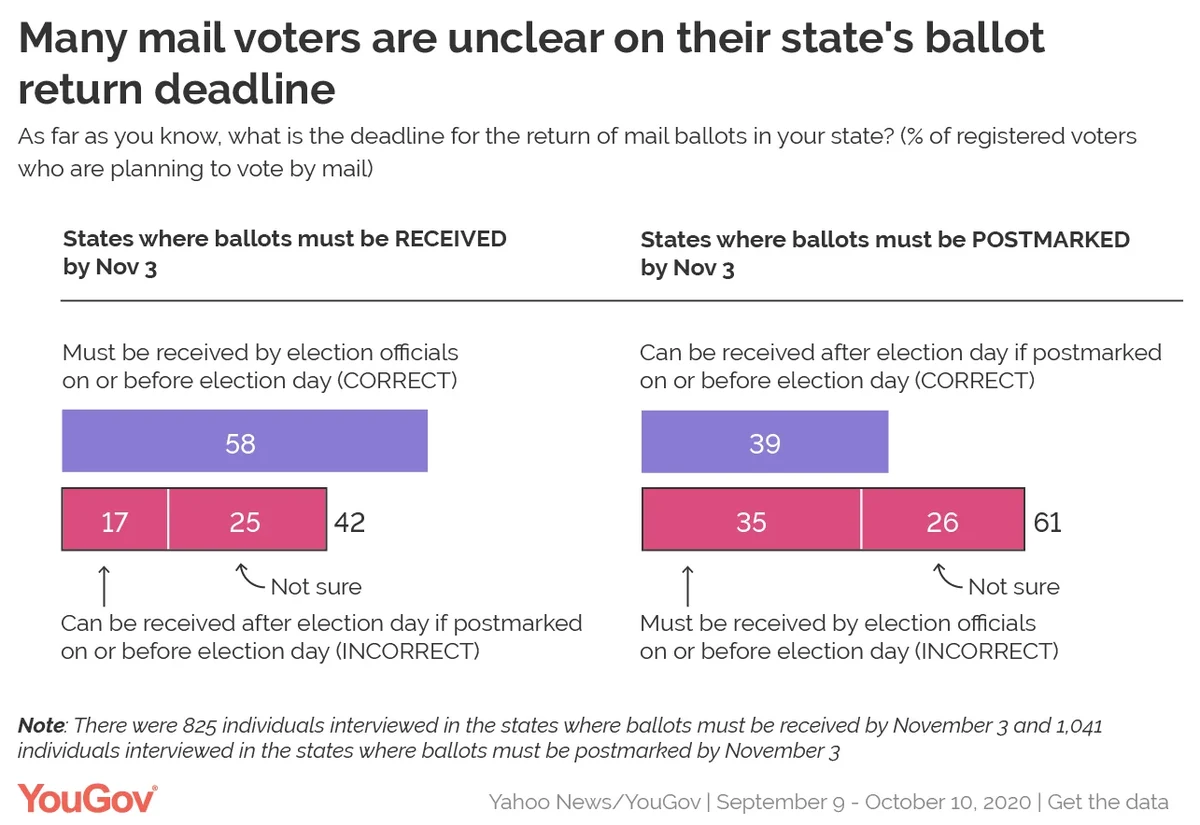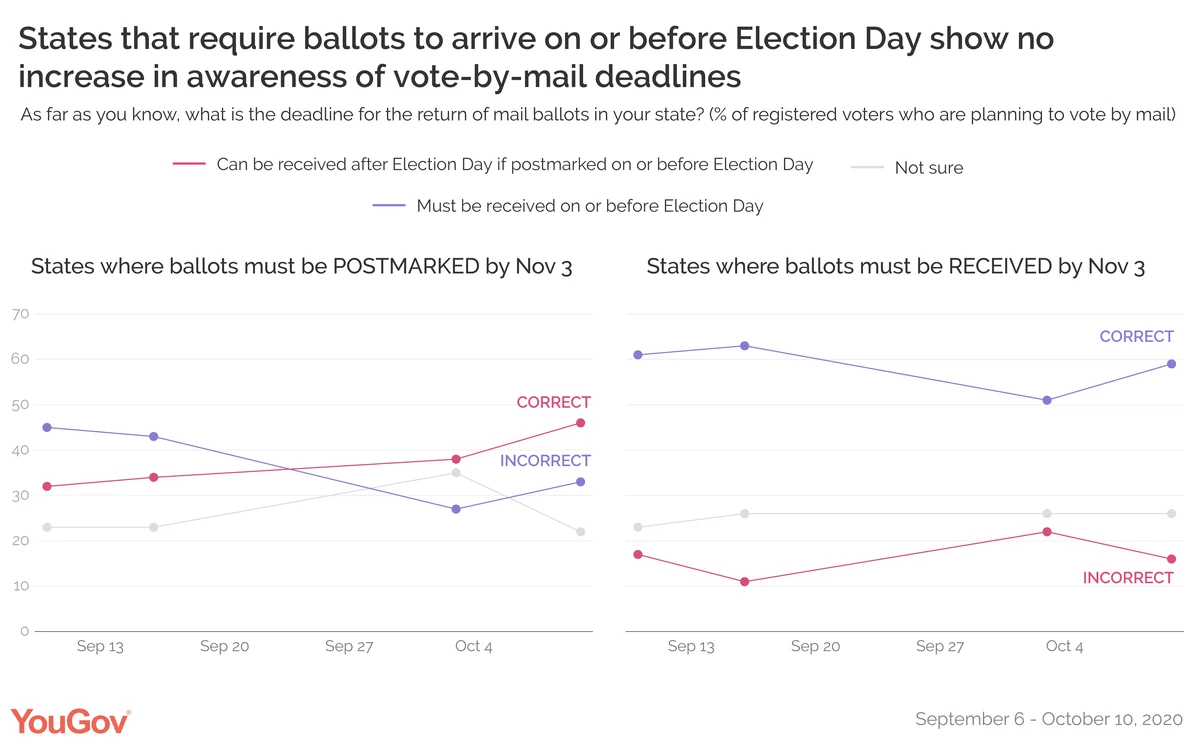The first reports of unusually heavy early voting are consistent with findings from YouGov’s recent tracking surveys: more than half of the nation’s voters plan to vote by mail or at early in-person voting sites, with Biden supporters far more likely to say they will do so than Trump supporters. Our surveys also show that the sharp rise in mail voting comes with considerable confusion about the deadlines for returning mail ballots.
YouGov surveys conducted for both The Economist and Yahoo News have been asking identical questions since early September about how registered voters plan to cast their ballots (or, as appropriate, about how they have already voted). Over the past five weeks, just over a third of registered voters (35%) say they will vote in person on Election Day. Far more either plan to vote or have already voted either by mail (38%) or in person before the election (21%). The overall differences from week to week, so far, have reflected mostly statistical noise rather than any consistent trend.
The big partisan differences have also been consistent over the past five weeks: Democrats say they are planning to vote (or have already voted) by mail (49%) nearly twice as often as Republicans (25%). Among independents who lean to neither party, voting or intent to vote by mail was a bit higher than usual this past week (40%) compared to the four previous weeks (34% on average).
The results from official statistics on early voting so far show similar trends. Early voting is proceeding at a “record pace,” according to the U.S. Elections Project, with 9.3 million people having voted as of October 11, compared to 1.4 million at the same time four years ago. In states with party registration, the Elections Project shows Democrats outnumber Republicans in returning their ballots by more than two-to-one (56% to 23% at time of writing).
The record pace of mail voting has raised concerns about sometimes complex mail voting rules and procedures that can lead to ballots being returned too late to be counted or discarded by voting officials for minor errors.
We asked about one particular rule: the deadline for ballot return. At time of writing, 27 states require that ballots be returned no later than November 3 (Election Day), 18 states plus the District of Columbia require that ballots be postmarked by November 3, and five more require postmarks one day before Election Day (November 2).
On four national surveys conducted by YouGov for Yahoo News in September and early October, 35% of all registered voters said ballots in their mail ballots “must be received by election officials on or before Election Day,” 24% said ballots “can be received after Election Day if postmarked on or before Election Day,” and 41% were unsure. The high level of uncertainty is understandable among those not planning to vote by mail, but even among those planning to vote by mail 26% were unsure about the return deadline.
To assess how well voters know the deadlines in their state, we tabulated responses separately for two types of states: those that require that ballots be returned by Election Day, and those accept ballots later if they are postmarked by Election Day (we set aside respondents from the five states that require a postmark by November 2).

Mail voters appear most familiar with the rules in states that require ballots returned by November 3. In these states, 58% of those planning to vote by mail know their ballots must be returned by Election Day, but many are either unsure (25%) or wrongly assume their ballot will be accepted if postmarked by Election Day (17%).
Confusion is greater in states that allow ballots to arrive after the election if they are postmarked no later than Election Day. In these states, just 39% know the post-mark rule, while nearly as many (35%) assume their ballots must be returned by Election Day and 26% are unsure
Confusion in this second category of states is less potentially disenfranchising, since it should not result in late arriving ballots – if anything, some voters may return their ballots sooner than necessary. We also see a pattern of rising awareness. Over the four surveys, awareness among mail voters that their returned ballots will be accepted if postmarked by Election Day has been gradually increasing (from 32% in early September, to 46% this past week).
The confusion in the first category of states can potentially do harm, however, since those who mail their ballots late will not have their votes counted. And unlike mail voters in the states that allow late arriving ballots, we see no growing awareness of the deadlines in the states that require ballots to arrive on or before Election Day.

Two things to bear in mind about voters who plan to vote by mail but wrongly assume election officials will accept a ballot with an Election Day postmark:
- The number of voters affected is relatively small, representing roughly 6% of all registered voters in the states that require receipt of ballots by Election Day.
- These same voters tilt heavily Democratic: they support Biden over Trump by 69% to 21%, reflecting the vote preference of others who plan to vote by mail, both in these states and nationwide.
Still, even a small number of lost votes can be consequential in close contests. The states that require ballots to arrive by November 3 include Arizona, Georgia, Florida, Iowa, Michigan, New Hampshire, Ohio and Wisconsin (though lawsuits remain underway in some states to allow for Election Day postmarks).
But three weeks remain, and public communication efforts by the news media and the campaigns can help lessen the confusion.
Related: Amy Coney Barrett: A qualified but divisive Supreme Court nominee
Methodology: The Yahoo! News surveys were conducted by YouGov using nationally representative samples US adult residents interviewed online between September 9-11 (n=1,577), September 15-17 (n=1,539), October 2-3 (n=1,202 registered voters) and October 9-10, 2020 (n=1,525 registered voters). The Economist surveys were conducted by YouGov using nationally representative samples US adult residents interviewed online between September 6-8 (n=1,500), September 13-15 (n=1,500), September 20-22 (n=1,500), September 27-30 (n=1,500 registered voters) and October 4-7, 2020 (n=1,500 registered voters). These samples were weighted according to gender, age, race, and education based on the American Community Survey, conducted by the US Bureau of the Census, as well as 2016 Presidential vote, registration status, and news interest
Image: Getty









